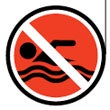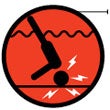Gear School: Trekking Poles
Pick the perfect telescoping sticks. Your legs will thank us in the morning.
Text by Kelly Bastone; Illustrations by Don Foley
How Locks Work/Strap Technique | Shop, Use, Fix

How Locks Work
Internal twist-lock
When you rotate sections in opposite directions, a plastic expander inside one shaft cams against the joint’s inner walls, keeping the pole segment from slipping. Twist-locks are the strongest mechanism available and rarely loosen accidentally, as other devices can. But cold can prevent them from locking/unlocking reliably, and they’re harder to adjust with mittened or sweaty hands.
External lever clamp
Closing the lever tightens a stainless steel, aluminum, or plastic band that clamps the two segments together; opening it lets you adjust pole length. These locks are reliable in freezing temps, but support less weight than twist-locks before collapsing (300 pounds max versus 400). Still, that’s more force than most hikers apply. Some need ample force to close tightly.
Push-button
A spring-loaded button on one pole segment locks into one of several holes on the other segment. This mechanism is fast to operate, but it’s not as strong, since the buttons can enlarge the holes over time, compromising the lock. Also, the predrilled holes mean you can’t fine-tune the length as precisely, and pressing the buttons can be tricky with gloves.

How Locks Work/Strap Technique | Shop, Use, Fix
SHOP
>> Shaft material Aluminum is the most commonly used since it’s light, affordable, and stiff. (Stiffer poles don’t flex as much when you weight them; that translates to efficient power transfer when you push off.) The strongest alloys (used in high-end poles) are heat-treated 70/75 aluminum, while the softer 60/61 grade is used in entry-level and kids’ models. Labels often don’t list this info, so either call the company or ask knowledgeable store clerks.
Carbon shafts, meanwhile, are 72 percent stiffer than aluminum and 7.5 percent lighter on average, but cost more—so they appeal to ultralighters who value weight savings above all. Carbon can be fragile: One nick often can cause the shaft to break, irreparably. (Aluminum, in contrast, bends or dents before breaking.) To compensate, the sturdiest carbon poles feature thick shaft walls and/or durable weave designs. Again, you can’t tell this from the label, so you have to ask savvy store reps or manufacturers, like Easton.
>> Swing weight A pole’s pure weight differs from its swing weight (how light it feels in action). A light tip requires less energy to swing. Tags don’t list this value, so test multiple poles to compare their feel.
>> Shaft shape Choose poles with a tapered lower shaft; this strengthens the pole at its greatest stress area (the tip segment) and reduces swing weight. Some shafts have shock absorbers, which increase weight but lower impact on wrists, elbows, and shoulders—desirable if you hike long distances or tackle rugged descents.
>> Locking mechanism These let you adjust length, a key feature. See left.
>> Grips Handles come in durable rubber or EVA foam, and less-sweaty cork. Sizes vary, with some gender-specific and winter versions available; wear gloves or mittens when you try the fit.
>> Bonus features Opt for wrist straps (bottom left) to decrease hand and arm strain; padded straps prevent chafing. Choose models with interchangeable baskets; wide ones keep poles on top of snow or mud.
USE
>> Poles reduce leg strain by about 20 percent by shifting some impact to the upper body. Preference dictates how much you weight the poles.
>> On flat ground, your elbows should bend at 90 degrees. For uphills, shorten the poles so you can plant them straight—or remove your hands from the straps and clasp the rubber grip (if available) below the handle. Lengthen poles for descents, so you can lean on them without bending at the waist. Shorten the uphill pole when traversing.
>> Hands should come up through the straps from below. That way, when you push down on the pole, the pressure gets distributed around your hand and eliminates the need to grip the pole tightly.
FIX
>> Some aluminum or plastic external clamps stretch naturally over time, so the segments might not lock in place when the lever’s closed. To fix, tighten the clamp by turning the screw at the base of the lever.
>> The expander can come unthreaded if you overloosen it. Solve by pulling the pole sections apart, then rethreading the internal expander.
>> Moisture inside aluminum shafts can cause oxidation (a white powder), which keeps the segments from sliding smoothly and weakens the lock. Prevent oxidation by separating the segments after every trip to let the interiors dry. To remove oxidation, use a long brush (like ones for cleaning gun barrels) or a cleaning kit ($19; leki.com).
>> Clean rubber and EVA foam grips with a soapy cloth. To remove gunk on cork grips, rub them with fine sandpaper.